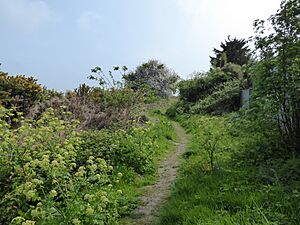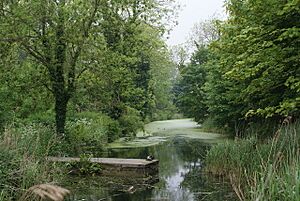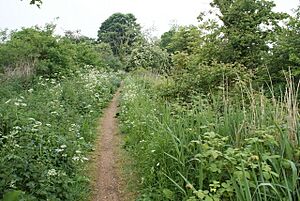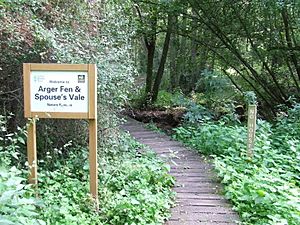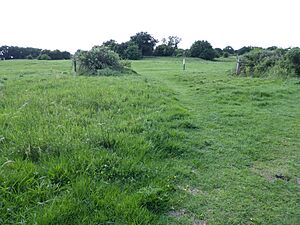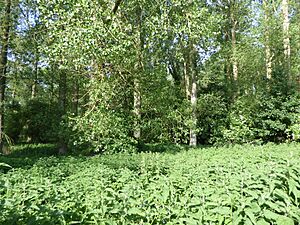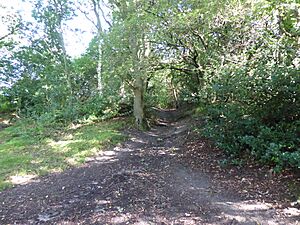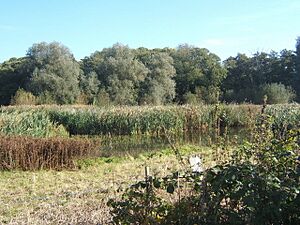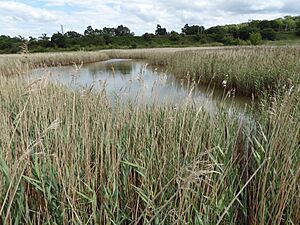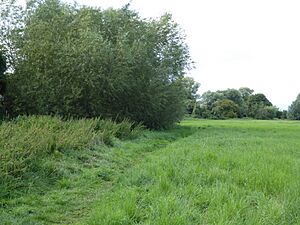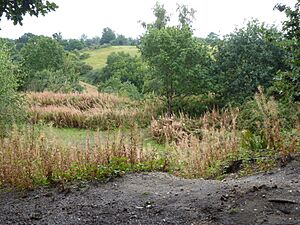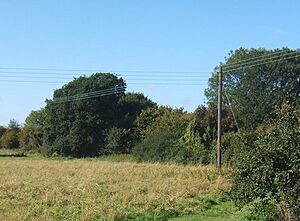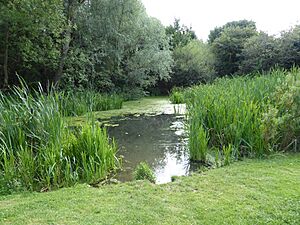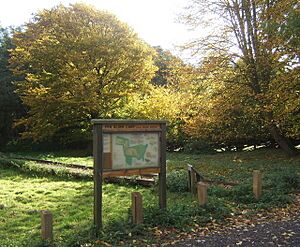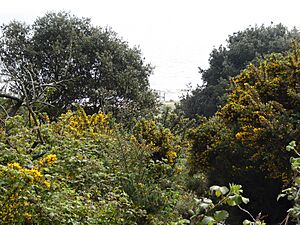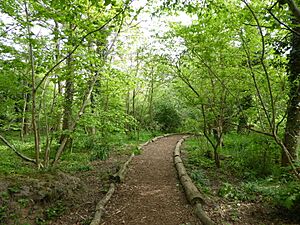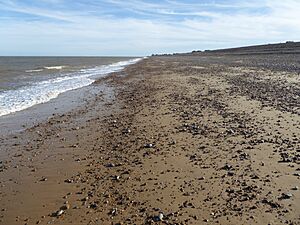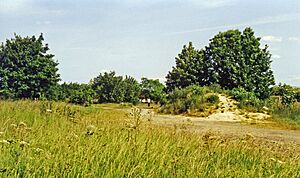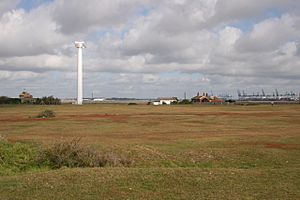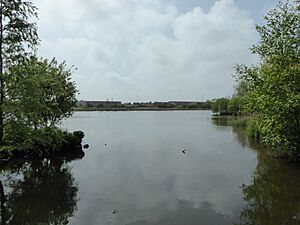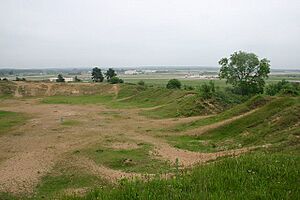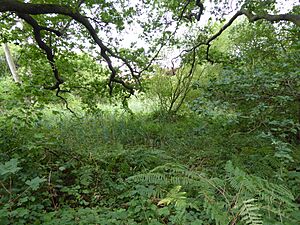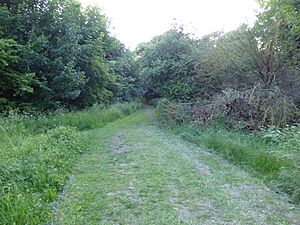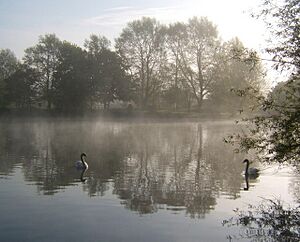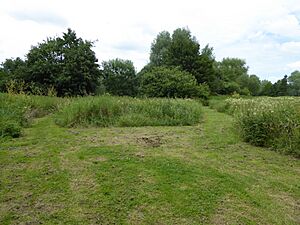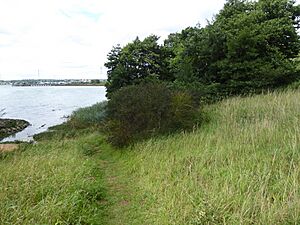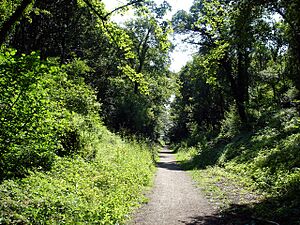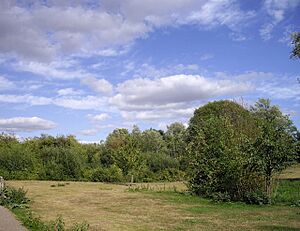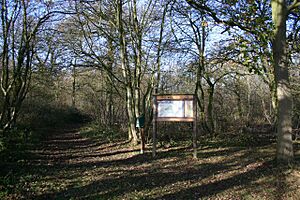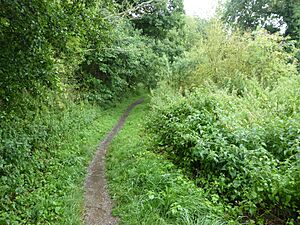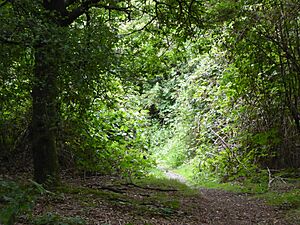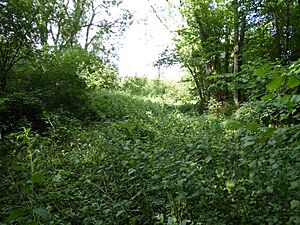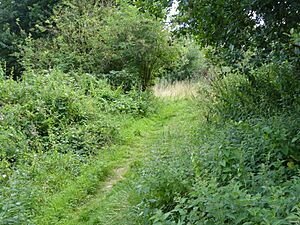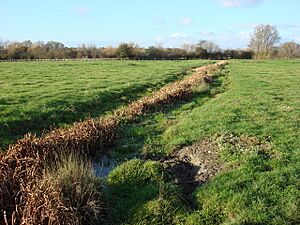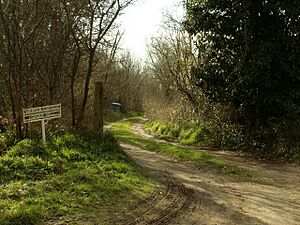List of local nature reserves in Suffolk facts for kids
Suffolk is a county in East Anglia, a region in eastern England. It shares borders with Norfolk to the north, Cambridgeshire to the west, and Essex to the south. Suffolk covers about 1,466 square miles (3,797 square kilometers) and is home to around 745,000 people. The main local government is Suffolk County Council, with five smaller councils helping to manage areas like Ipswich and East Suffolk. Much of Suffolk's coast has wide river mouths, called estuaries, with lots of wetlands and marshy areas.
Local Nature Reserves (LNRs) are special places for nature, chosen by local councils. These councils must legally control the land, either by owning it or having an agreement with the owner. LNRs are important because they have unique plants, animals, or interesting geology. Local councils work to protect these areas and can even make local rules to help manage them.
As of 2017, Suffolk has 36 Local Nature Reserves. Some of these reserves are also part of other important nature areas. For example, three are in Areas of Outstanding Natural Beauty (AONBs), which are beautiful landscapes. Seven are Sites of Special Scientific Interest (SSSIs), meaning they are nationally important for their wildlife or geology. Two of these reserves are looked after by the Suffolk Wildlife Trust, a charity that protects wildlife. The biggest LNR is Sudbury Common Lands, covering 50.3 hectares (124 acres) of ancient wetlands. The smallest is Alderman Canal West, which is 1.0 hectare (2.5 acres) and has rare wetland plants.
Contents
- Discovering Suffolk's Nature Reserves
- Alderman Canal East
- Alderman Canal West
- Arger Fen
- Aspal Close
- Barton Mills Valley
- Bixley Heath
- Bobbits Lane
- Bourne Park Reed Beds
- Bramford Meadows
- Bridge Wood
- Broom Hill, Hadleigh
- Church Meadow
- The Dales Open Space
- Fen Alder Carr
- Gunton Warren and Corton Woods
- Gunton Wood
- The Haven, Aldeburgh
- Haverhill Railway Walks
- Landguard Common
- Leathes Ham
- Maidscross Hill
- Mill Stream
- Millennium Wood, Ipswich
- Moreton Hall Community Woods
- Needham Lake
- The Pennings, Eye
- Pipers Vale
- Railway Walk, Hadleigh
- The Railway Walks
- Rede Wood
- Riverside Walk, Hadleigh
- Sandlings
- Spring Wood, Belstead
- Stoke Park Wood
- Sudbury Common Lands
- Tiger Hill
- See also
Discovering Suffolk's Nature Reserves
Here's a look at some of the amazing Local Nature Reserves you can find in Suffolk:
Alderman Canal East
This reserve in Ipswich has a path running along a canal, which is a part of the River Gipping. You'll also find areas with tall reeds, a ditch, and grassy spots with tall herbs. It's home to some unusual wetland plants. Keep an eye out for birds like spotted flycatchers, kingfishers, and reed buntings.
Alderman Canal West
Also in Ipswich, this reserve has paths along the canal and through areas of reeds. There's also grassland with tall herbs, and the canal bank is known for its rare wetland plants. Like its eastern neighbor, you might spot kingfishers and reed buntings here.
Arger Fen
Located near Assington in Babergh, this site has very old woodlands and wet meadows. It's a Site of Special Scientific Interest (SSSI) and part of the Dedham Vale National Landscape, a beautiful protected area. It's also managed by the Suffolk Wildlife Trust. You'll find many different kinds of trees, such as wild cherry, field maple, and crab apple. Rare animals like hazel dormice and barbastelle bats live here.
Aspal Close
Near Beck Row, this reserve has grasslands, woodlands, and bushy areas. Almost 300 types of plants and six kinds of bats have been found here. There are also about 200 ancient oak trees, some of which might be 1,000 years old! The site has a car park and even a football pitch.
Barton Mills Valley
This diverse site near Mildenhall is a Site of Special Scientific Interest (SSSI). It features areas of reeds, alder carr (a type of wet woodland with alder trees), willow trees, and sedge plants. It's a great place for a picnic, with benches, a car park, and easy access for everyone.
Bixley Heath
In Ipswich, this Site of Special Scientific Interest (SSSI) has dry heathland on higher ground and swampy areas in the valley. The heath is mostly covered in common heather, along with other plants like bell heather. The swamp has a thick growth of lesser pond-sedge.
Bobbits Lane
This reserve in Ipswich features wet meadows with grassy paths. It's a great place to spot wildlife such as otters, water voles, kingfishers, egrets, and toads.
Bourne Park Reed Beds
Found within Bourne Park in Ipswich, this nature reserve is a long strip of reed beds, scrubby woodland, and tall herb fen. It runs along the north bank of Belstead Brook.
Bramford Meadows
On the east bank of the River Gipping in Bramford, this site has grassland and scrub. It's crisscrossed by wet ditches and the old path of the river. In the ditches, you can find plants like water forget-me-not, water mint, brooklime, and water figwort.
Bridge Wood
This woodland in Ipswich has been managed for at least 400 years and is home to several ancient oak trees. There are also areas of pine trees, which are being thinned out to create a more mixed woodland.
Broom Hill, Hadleigh
This former quarry in Hadleigh is now covered with woodland, grassland, and scrub. It has many old trees, including pollarded oaks and small-leaved limes (trees with high branches removed) and coppiced hazel and lime trees (cut at ground level to encourage new growth).
Church Meadow
Once the garden of Combs Hall, which was taken down in 1756, this reserve in Stowmarket still has old earth banks and a round pond. The pond is full of frogs, newts, toads, and many dragonflies. Sheep graze in the meadow, helping to keep it healthy.
The Dales Open Space
Most of this former quarry in Ipswich is now secondary woodland (forest that has grown back after being cleared). It also has bushy areas, two ponds fed by springs, and pools that appear seasonally. The northern part is a flat valley, while the southern part slopes steeply upwards.
Fen Alder Carr
This reserve in Stowmarket has many different habitats, including open water, alder carr woodland, and tall fen (a type of marshy wetland). You'll find a large rookery (a colony of rooks) high in the trees, and other birds like siskins, chaffinches, and redpolls.
Gunton Warren and Corton Woods
This coastal site near Lowestoft is managed by the Suffolk Wildlife Trust. Gunton Warren has sand dunes, shingle beaches, lowland heath, and cliff slopes. Rare migrating birds like icterines and yellow-browed warblers can be seen here. Corton Woods has mature trees and a variety of plants, including lesser celandine, bee orchids, and common spotted orchids.
Gunton Wood
Once part of the gardens of Gunton Old Hall, which was demolished in 1963, this wood in Lowestoft has trees like lime, oak, and copper beech. It also features a pond and beautiful green winged and bee orchids.
The Haven, Aldeburgh
This site in Aldeburgh covers the beach north of the town and an area of lagoons and reedbeds, which are protected nature reserves. It's a Site of Special Scientific Interest (SSSI) and part of the Suffolk Coast and Heaths Area of Outstanding Natural Beauty. You can also see a sculpture called Scallop by Maggi Hambling here, which honors the composer Benjamin Britten.
Haverhill Railway Walks
This is a footpath along a three-mile stretch of an old railway line in Haverhill. Much of it is covered with bushes and large trees, creating a wildlife corridor that allows many different animals and plants to thrive right through the middle of Haverhill.
Landguard Common
Located in Felixstowe, this Site of Special Scientific Interest (SSSI) has a rare habitat of vegetated shingle (a beach made of small stones with plants growing on it). You can find plants like sea kale and yellow horned poppy here. Birds such as purple sandpipers, wheatears, and snow buntings visit the site.
Leathes Ham
In the Middle Ages, this site in Lowestoft was used for digging peat (a type of soil made from decayed plants). Later, it flooded and became a lake. It now has a reedbed, ditches, and marshes where wildfowl (water birds) breed. Plants like ragged robin and southern marsh orchid grow here.
Maidscross Hill
This very dry grassland near Brandon is a Site of Special Scientific Interest (SSSI) and a Nature Conservation Review site. It's home to four nationally rare plants: Breckland wild thyme, Spanish catchfly, grape hyacinth, and sickle medick. The site is not grazed, which has allowed some bracken and scrub to grow, but this also provides more nesting spots for birds.
Mill Stream
This long, narrow reserve in Ipswich follows the banks of a stream. It also has ponds, wet carr (a type of wet woodland), other woodland, wildflower grassland, and willow bushes. You can see ancient oak trees and water voles here.
Millennium Wood, Ipswich
This ancient, semi-natural wood in Ipswich is mainly made up of hornbeam and coppiced lime trees. New young trees have been planted at its edges. In spring, the wood is filled with many flowers like bluebells, wild garlic, and archangel.
Moreton Hall Community Woods
This reserve near Bury St Edmunds is spread across six separate areas. It includes woodland, grassland, a pond, and paths for walking and cycling.
Needham Lake
The lake in Needham Market was formed in old sand and gravel pits. It has many different animals and plants living in its water, marsh, and scrub areas. There are both grass and paved paths for visitors.
The Pennings, Eye
This site on the east bank of the River Dove is managed as a hay meadow. Along the river bank, you might spot kingfishers and water voles.
Pipers Vale
Located on the bank of the River Orwell in Ipswich, this site is part of Orwell Country Park. It has many different habitats, including heathland, reedbeds, scrub, and alder carr. More than 100 bird species have been recorded here, such as redwings, whimbrels, and bullfinches.
Railway Walk, Hadleigh
This walk starts at the old station building in Hadleigh, which is now a private house. The path is flat in some places, on raised banks in others, and slopes downwards in parts. Most of the walk is lined with trees.
The Railway Walks
This walk near Sudbury has a variety of animals and plants in habitats like water meadows, streams, ditches, and ponds. Birds you might see include willow warblers, kingfishers, woodpeckers, mallards, moorhens, and swans.
Rede Wood
This semi-natural wood in Ipswich grows on boulder clay soil. It's mainly made up of pedunculate oak and ash trees, with a lower layer of coppiced hazel. The wood has 38 different plant species that show it's a very old woodland.
Riverside Walk, Hadleigh
This long, narrow site on the west bank of the River Brett in Hadleigh includes two footpaths and the alder woodland and fen between them. In the marshy, silty ditches, you can find great willowherb and meadowsweet. Birds like warblers and finches are also present.
Sandlings
This reserve in Ipswich has acid grassland, a wildflower meadow, and areas of scrub. Nearly 70 types of birds and 22 types of butterflies have been seen here, including the rare white-letter hairstreak butterfly.
Spring Wood, Belstead
This ancient oak and hornbeam wood in Ipswich has an undergrowth of hazel. You can also find small-leaved lime trees growing in groups several meters wide. These groups are actually one single tree genetically, having regrown from coppiced stumps many decades ago.
Stoke Park Wood
This ancient wood in Ipswich was once part of the Stoke Park estate. It still has parts of a Victorian drainage system. It used to be called Fishpond Covert because it had a large fishpond. Today, it's a mixed woodland with grassy trails and open clearings.
Sudbury Common Lands
This large site in Sudbury has very old wetlands with ponds and ditches. It's home to locally rare plants like flowering rush, tubular water dropwort, and round-fruited rush. There's also grassland that has never been ploughed, with many different grasses and wildflowers.
Tiger Hill
Near Assington, this site is a Site of Special Scientific Interest (SSSI) and part of the Dedham Vale National Landscape. It features woodland, heathland, and fenland. Animals found here include badgers, bats, and rare and endangered dormice.
See also
- List of Sites of Special Scientific Interest in Suffolk
- National nature reserves in Suffolk


